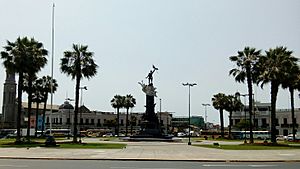Plaza Bolognesi facts for kids
The Plaza Bolognesi is a large roundabout in Lima, the capital city of Peru. It sits right where several important avenues meet, like Brasil Avenue, Arica Avenue, and Alfonso Ugarte Avenue.
This plaza is named after a brave national hero, Colonel Francisco Bolognesi. He was a key figure in the Battle of Arica during the War of the Pacific. The plaza is especially important because it's where the Ceremony of the Flag takes place every year on June 7th, which is Peruvian Flag Day. The plaza officially opened on November 6, 1905.
Contents
What Does Plaza Bolognesi Look Like?
The buildings around Plaza Bolognesi were originally designed in a similar style. They were painted blue, giving the area a unified look. Today, some of these buildings show signs of age and are quite busy.
In the very center of the plaza, there's a tall monument. It has an obelisk, which is a tall, four-sided pillar, topped with a statue. This statue shows Colonel Bolognesi standing tall and proud. He holds the Peruvian flag in one hand and a revolver in the other. This impressive statue was created by a Peruvian artist named Artemio Ocaña. It was made from bronze, using material from three tons of old artillery shells! This current statue was put in place in 1954.
The Story of the Statues
The first statue in Plaza Bolognesi was made by a Spanish artist named Agustín Querol. This original sculpture showed Bolognesi holding onto a flagpole, looking like he was about to fall. It captured the moment he was killed in battle.
However, this statue caused some debate. Famous Peruvian writer Manuel González Prada and others felt it didn't show Bolognesi as the strong hero he was. They thought it made him look too weak.
For many years, no government changed the statue. But in 1954, during the time President Manuel A. Odría was in charge, a new statue was finally commissioned. The Peruvian sculptor Artemio Ocaña was chosen to create it. This new statue showed Bolognesi in a more heroic and triumphant pose.
This change also led to new discussions. Some people believed the old Querol statue was a beautiful piece of art. They felt it was wrongly removed and replaced by a less artistic one. Even a young journalist named Mario Vargas Llosa (who later became a famous writer) called the new statue a "grotesque puppet."
How the Plaza Was Opened
The first step for building Plaza Bolognesi happened on July 29, 1902, when the first stone was laid. The monument itself, created by Agustín Querol, took two years to finish. It arrived in Peru in early 1905, in large pieces that were put together by a worker named Enrique Días. At this time, José Pardo y Barreda was the President of Peru.
The opening ceremony was planned for November 4th, which was Bolognesi's birthday. But it was moved to November 6th. Many citizens gathered in the streets leading to the plaza, eager to see it. A special guest at the ceremony was Roque Sáenz Peña, an Argentinian general who had fought alongside Bolognesi in the defense of Arica. He even led the military parade that day.
President José Pardo led the ceremony. When the statue of Bolognesi was finally revealed, the crowd cheered loudly. Then, General Sáenz Peña, standing before the statue of his old commander, became very emotional. All he could say was: "Present, my colonel!"
On that same day, the very first oath of allegiance to the flag was taken by new soldiers. This ceremony has continued every year since then, on June 7th, to remember the Battle of Arica. To end the ceremony, President Pardo gave medals to the survivors of the Battle of Arica. These medals were given by the Congress of Peru to show the nation's thanks and respect.
See also
 In Spanish: Plaza Bolognesi (Lima) para niños
In Spanish: Plaza Bolognesi (Lima) para niños
- Plaza San Martín


